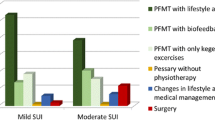Abstract
The treatment of incontinence presents many unique issues for biofeedback therapists that are routine for professionals in fields such as nursing or medicine. Although, all professional practice is guided by ethical standards, the unique circumstances encountered during biofeedback treatments for this disorder warrant the development of specific guidelines. This is true whether insertable or surface EMG devices are used. Therefore, the purpose of this article is to propose a set of ethical guidelines for biofeedback therapists. The intended audience includes professionals such as psychologists, clinical psychophysiologists, and other mental health-care providers who use biofeedback techniques. These are not formally endorsed by any professional organizations (e.g., APA, AAPB) at this time. Ethical considerations include proper medical evaluation, informed consent, patient instruction, disrobing, nonerotic physical contact, patient safety, and patient satisfaction.
Similar content being viewed by others
References
American Psychological Association Ethics Committee (1992). Ethical principles of psychologists and code of conduct.American Psychologist, 47(12), 1597–1661.
Andreassi, J. L. (1989).Psychophysiology: Human behavior and physiological response. Hillsdale, NJ: Lawrence Erlbaum Associates.
Association for Applied Psychophysiology and Biofeedback (1992).Standards and guidelines for biofeedback applications in psychophysiological self-regulation. Wheat Ridge, CO.
Biofeedback Certification Institute of America (1992).Biofeedback certification institute of America revised blueprint knowledge statements. Wheat Ridge, CO.
Brakel, S. J., Parry, J., & Weiner, B. A. (1985).The mentally disabled and the law. Chicago: American Bar Foundation.
Burns, P., Pranikoff, K., Nochajski, T., Hadley, E. C., Levy, K. J., & Ory, M. G. (1993). A comparison of effectiveness of biofeedback and pelvic muscle exercise treatment of stress incontinence in older community-dwelling women.Journal of Gerontology Medical Sciences, 48, M167-M174.
Corcos, J., Drew, S., & West, L. (1992). Urinary and fecal incontinence: The use of electromyographic biofeedback for training pelvic floor musculature.Electromyography: Applications in Physical Therapy, 4, 1–4. (Available from Thought Technology Ltd., Cimentra Industrial Park, 8396 North, West Chazy, NY 12992.)
Court, J. H. (1987). Addressing undressing.Australian Psychologist, 22(1), 17–29.
Dougherty, M. C., Abrams, R., & McKey, P. L. (1986). An instrument to assess the dynamic characteristics of the circumvaginal musculature.Nursing Research, 35, 202–206.
Dougherty, M. C., Bishop, K. R., Abrams, R. M., Batich, C. D., & Gimotty, P. A. (1989). The effect of exercise on the circumvaginal muscles in postpartum women.Journal of Nurse-Midwifery, 34(1), 8–14.
Drew, S. J. (1990). A short-term biofeedback strategy for treating bladder incontinence in outpatient females.Dissertation Abstracts International, 51, 5B.
Ennis, M., Clark, A., & Grudzinskas, J. G. (1991). Change in obstetric practice in response to fear of litigation in the British Isles.Lancet, 338, 616–618.
Goisman, R. M., & Gutheil, T. G. (1992). Risk management in the practice of behavior therapy: Boundaries and behavior.American Journal of Psychotherapy, 46(4), 532–543.
Holub, E. A., & Lee, S. S. (1990). Therapists' use of nonerotic physical contact: Ethical concerns.Professional Psychology Research in Practice, 21(2), 115–117.
Keifer, W. S. (1993). Preparing for obstetrics in the twenty-first century: Quo vadis?American Journal of Obstetrics and Gynecology, 168, 1798–1790.
Kincaid, J., Fishburne, R., Rogers, R., & Chissom, B. (1975) Derivation of new readability formulas (Automated, Readability Index, Fog Count, and Flesch Reading Ease Formula) for navy enlisted personnel (Brand Report 8-75). Millington, TN: Chief of Naval Training.
Middaugh, S. J., Whitehead, W. E., Burgio, K. L., & Engel, B. T. (1989). Biofeedback in treatment of urinary incontinence in stroke patients.Biofeedback and Self-Regulation, 14(1), 3–19.
O'Donnell, P. D., & Doyle, R. (1991). Biofeedback therapy technique for treatment of urinary incontinence.Urology, 37(5), 432–436.
Olson, R. P. (1995). Models of practice: The delivery of biofeedback services. In M. S. Schwartz (Ed.),Biofeedback (pp. 706–711). New York: Guilford Press.
Percival, G., & Striefel, S. (1994). Ethical beliefs and practices of AAPB members.Biofeedback and Self-Regulation, 19(1), 67–93.
Perry, J. D. (1990) The Perry protocol for treatment of incontinence. (Available from Biotechnologies, Inc., 242 Old Eagle School Road, Strafford, PA 19087.)
Perry, J. D., & Hullett, L. T. (1990). The role of home trainers in Kegel's exercise program for the treatment of incontinence.Ostomy Wound Management, 30(Sept/Oct), 46–57.
Scholendorff v. Society of N.Y. Hospital, 211 N.Y. 125, 105 N.E.92 (1914).
Scott, D. (1992). Are your patients satisfied?Postgraduate Medicine, 82(5), 169–176.
Schwartz, M. (1995). Job descriptions. In M.S. Schwartz (Ed.),Biofeedback (pp. 726–736). New York: Guilford Press.
Society for the Scientific Study of Sex (1991).Society for the Scientific Study of Sex Statement of Ethical Guidelines. Mount Vernon, IO.
Susset, J. G., Galea, G., & Read, L. (1990). Biofeedback therapy for female incontinence due to low urethral resistance.Journal of Urology, 143, 1205–1208.
Tries, J., & Eisman, E. (1995). Urinary incontinence: Evaluation and biofeedback treatment. In M. S. Schwartz (Ed.),Biofeedback (pp. 597–629). New York: Gullford Press.
Urinary Incontinence Guideline Panel (1992) Urinary incontinence in adults: Clinical practice guideline. AHCPR Publication No. 92-0038. Rockville, MD: Agency for Health Care Policy and Research, Public Health Service, U.S. Department of Health and Human Services.
Watt, M. (1995).Biofeedback-assisted Kegel exercises for urinary incontinence: A controlled treatment outcome study using non-invasive surface EMG. Unpublished doctoral dissertation. Illinois Institute of Technology, Chicago, IL.
Woody, R. H., Alperstein, L. P., Daily, D. M., Earle, R. H., Gilmore, L. G., Hotchner, B., Lunquist, J. A., & Tatum, M. L. (1992).1992 AASECT American Association of Sex Educators, Counselors, and Therapists. Chicago: AASECT Code of Ethics Revision Committee.
Workman, D., Cassisi, J., & Dougherty, M. (1993). Validation of surface EMG and intravaginal activity and intra-abdominal activity: Implications for biofeedback-assisted Kegel exercises.Psychophysiology, 30, 120–125.
Author information
Authors and Affiliations
Rights and permissions
About this article
Cite this article
Paul, P., Cassisi, J.E. & Larson, P. Ethical and practice considerations for biofeedback therapists in the treatment of urinary incontinence. Biofeedback and Self-Regulation 21, 229–240 (1996). https://doi.org/10.1007/BF02214735
Issue Date:
DOI: https://doi.org/10.1007/BF02214735




